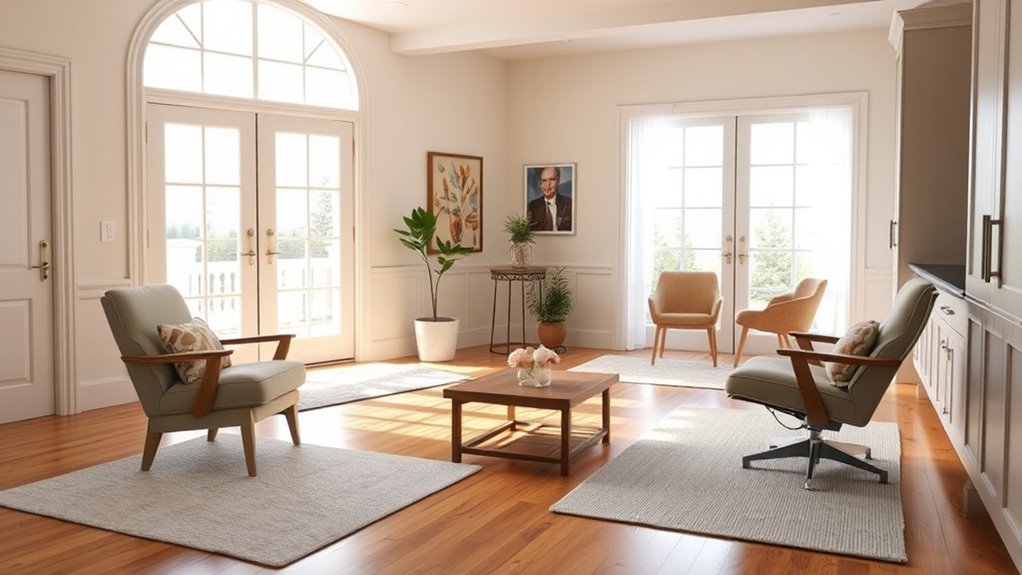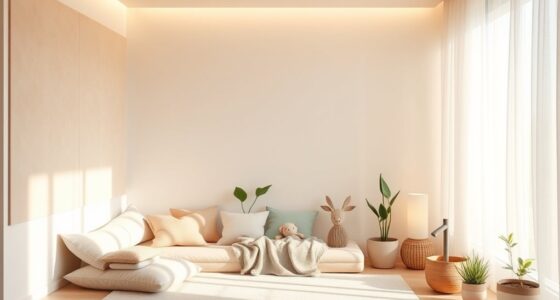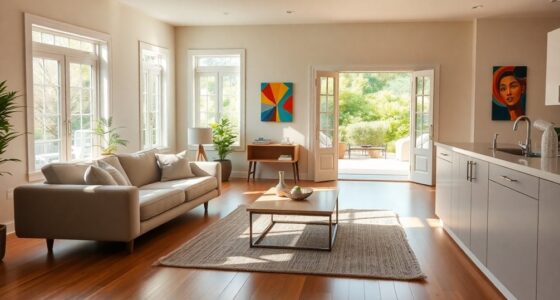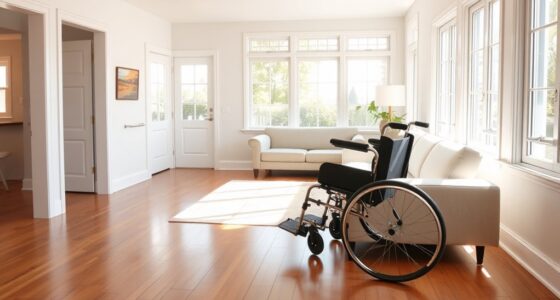Universal design principles help you create homes that are comfortable and accessible for everyone. You can achieve this by incorporating adaptable features like lever handles, wide doorways, and smooth thresholds, making spaces easier to navigate. Designing ergonomic layouts ensures safety and reduces strain, regardless of age or ability. Sustainable practices add to overall comfort and health. By planning thoughtfully, you create environments that support varying needs and promote inclusivity. Continue exploring to discover how these principles can transform your home.
Key Takeaways
- Incorporate adaptive features like lever door handles and smooth thresholds for easier, inclusive access.
- Design ergonomic layouts with reachable storage and appropriate countertop heights to enhance comfort for all users.
- Use environmentally friendly materials and sustainable practices to promote health and long-term comfort.
- Plan for flexible modifications such as wider doorways and adjustable lighting to accommodate changing needs.
- Create intuitive, barrier-free spaces that prioritize safety, ease of navigation, and universal accessibility.

Have you ever wondered how to create spaces and products that work for everyone? It’s a question that sits at the heart of universal design principles. When you focus on making environments accessible and functional for all, you’re embracing adaptability and inclusivity. One key aspect is incorporating adaptive features that can be easily modified to meet diverse needs. Think about door handles that can be operated with a closed fist or levers instead of knobs—these small changes can make a big difference. Adaptive features ensure that whether someone uses a wheelchair, has limited dexterity, or faces other mobility challenges, they can navigate and use their home comfortably. It’s about designing spaces that are flexible, so they can evolve with the occupants’ needs over time.
Creating adaptable, accessible spaces with features that evolve to meet diverse needs enhances comfort and inclusivity for all.
Equally important are ergonomic layouts, which prioritize comfort and efficiency. When you plan your home with ergonomics in mind, you reduce strain and fatigue, making daily activities easier and safer. For example, placing frequently used items within easy reach or designing countertops at appropriate heights can prevent unnecessary bending or stretching. An ergonomic layout considers the natural movements and physical limitations of users, allowing everyone to move through the space effortlessly. It’s not just about aging in place; it’s about creating a home that actively supports your well-being at every stage of life. Incorporating environmental sustainability into design can also enhance the overall comfort and health of the space for all users. Additionally, understanding divorce statistics can help homeowners better plan for adaptable spaces that accommodate changing family dynamics.
Implementing universal design isn’t complex; it’s about thoughtful planning and intentional choices. Start by evaluating how spaces can be made more adaptable—such as installing wider doorways to accommodate mobility devices or ensuring thresholds are smooth for easy passage. These adaptive features also include adjustable lighting and temperature controls, which can be tailored to different preferences or needs. When you design with ergonomic layouts, you’re focusing on the user’s experience—placing light switches at accessible heights, providing ample space for movement, and ensuring furniture placement promotes good posture. Furthermore, cultivating Cultural Intelligence in design can help anticipate diverse preferences and needs, making spaces truly inclusive for a wide range of users.
Ultimately, universal design principles aim to create homes that are intuitive, safe, and comfortable for everyone, regardless of age or ability. By integrating adaptive features and ergonomic layouts, you’re building a space that’s not only inclusive but also enhances daily living for all residents. It’s about thinking ahead, anticipating needs, and crafting environments that empower and support everyone who steps through your door.
Frequently Asked Questions
How Can Universal Design Reduce Long-Term Home Modification Costs?
You can save money long-term by incorporating universal design principles early on. This approach acts as a cost-saving strategy by reducing future renovation expenses and adapting your home for changing needs. Plus, universal design offers maintenance benefits, making upgrades and repairs easier and less costly over time. By planning ahead, you avoid costly modifications later, ensuring your home remains comfortable and functional for everyone without breaking the bank.
What Are the First Steps to Implementing Universal Design in an Existing Home?
The first step to making your home universally designed is to avoid chaos and confusion. Start with a thorough home assessment to identify barriers and needs. Then, schedule a design consultation with a professional who specializes in universal design. This clear plan helps you prioritize modifications, ensuring your home becomes more accessible, comfortable, and adaptable for everyone—saving you money and stress in the long run.
How Does Universal Design Impact Home Resale Value?
Universal design positively impacts your home’s resale value by boosting marketability and property appeal. When you incorporate accessible features, more buyers see your home as functional and inclusive, making it stand out. This can lead to quicker sales and higher offers. By making your home universally accessible, you’re not just improving daily living; you’re also enhancing its attractiveness to a broader range of potential buyers, increasing its overall value in the market.
Are Universal Design Features Suitable for Small or Apartment Living?
Did you know that 65% of apartment dwellers prefer adaptable furniture? You’ll find universal design features perfect for small or apartment living because they focus on space-saving solutions and flexibility. These features make your home more comfortable, functional, and stylish without sacrificing space. Whether it’s multi-use furniture or accessible layouts, universal design enhances your living experience and adapts seamlessly to your needs, no matter your space constraints.
Can Universal Design Principles Be Customized for Specific Disabilities?
You can definitely customize universal design principles for specific disabilities. By incorporating personalized adaptations and flexible configurations, you guarantee your home meets your unique needs. For example, adjustable countertops or lever door handles can make daily tasks easier. These modifications allow you to create a comfortable, accessible space that adapts to your changing requirements, making your home both functional and welcoming for your specific situation.
Conclusion
By embracing universal design principles, you might think you’re creating a future-proof home. Ironically, in aiming for perfection for everyone, you often end up designing for no one—except perhaps the elusive ideal occupant. But in truth, your efforts guarantee comfort and accessibility for all, proving that sometimes, the simplest approach is the most sophisticated. So go ahead, make your home truly inclusive—you might just find it’s the one thing everyone agrees on.









